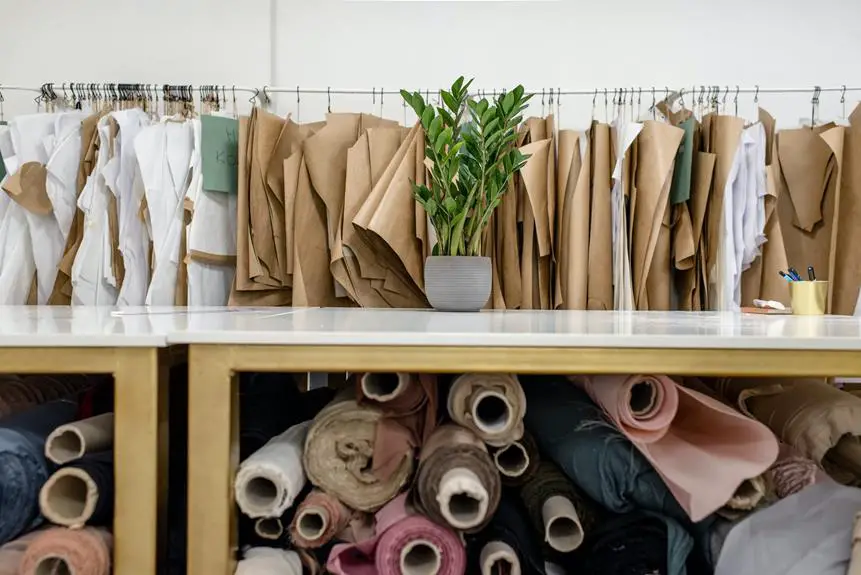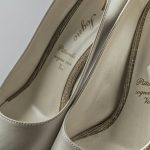So, you've heard the term 'gabardine fabric' thrown around, but do you really know what it is? Let's break it down for you.
Gabardine is a tightly woven, twill fabric known for its durability and wrinkle resistance. It has a distinct diagonal rib pattern and is commonly used in tailored garments, workwear, and outerwear.
The weaving process of gabardine contributes to its strength and resilience, making it a popular choice for both fashion and practical purposes.
From its origins to its modern uses, understanding gabardine fabric will give you a deeper appreciation for its timeless appeal and versatility.
Key Takeaways
- Gabardine fabric was developed by Thomas Burberry in the 19th century and became popular during World War I.
- Gabardine fabric is tightly woven, durable, and resistant to wear and tear, making it suitable for tailored suits and outerwear.
- The fabric has a smooth texture with a sleek appearance and feels luxurious against the skin.
- Gabardine fabric is water-resistant due to its tightly woven structure and Durable Water Repellent (DWR) finish, making it an ideal choice for outerwear and raincoats.
The Origins of Gabardine
Exploring the origins of gabardine, you'll discover a durable and tightly woven fabric with a fascinating history.
The origins of gabardine can be traced back to the 19th century when it was first developed by Thomas Burberry, the founder of the iconic Burberry fashion house. The fabric was initially created to meet the needs of outdoor enthusiasts and military personnel, owing to its remarkable durability and water-resistant properties. Its evolution over time has seen advancements in weaving techniques, resulting in a finer and more versatile fabric.
The historical significance of gabardine is noteworthy, as it became the fabric of choice for trench coats worn by British soldiers during World War I. Its popularity soared during this time and has continued to be a staple in fashion due to its timeless appeal and practicality.
In modern times, gabardine is widely used in various applications such as tailored suits, trousers, and skirts, reflecting its adaptability to evolving fashion trends. Its enduring presence in the fashion industry is a testament to its enduring quality and timeless style.
Characteristics of Gabardine Fabric
Gabardine fabric is known for its durable weave that makes it resistant to wear and tear, making it a great choice for long-lasting garments.
Its smooth texture gives it a sleek and polished appearance, perfect for both formal and casual attire.
Additionally, the water resistance of gabardine fabric makes it an ideal choice for outerwear, keeping you dry and stylish in various weather conditions.
Gabardine's Durable Weave
Looking for a fabric that can withstand wear and tear? Gabardine's durable weave makes it a top choice for long-lasting clothing. The weaving techniques used to create gabardine result in a tightly woven fabric that's exceptionally strong and resilient. This makes it resistant to wrinkles and stretching, ensuring that your garments maintain their shape and structure even after multiple wears.
The durability of gabardine also makes it suitable for various types of clothing, from tailored suits to outerwear. Additionally, the fabric's water resistance and smooth texture further contribute to its longevity, making it a practical choice for everyday wear.
With gabardine, you can enjoy clothing that not only looks sophisticated but also stands the test of time.
Gabardine's Smooth Texture
You'll frequently find that gabardine fabric has a smooth texture that adds to its appeal and versatility. This smoothness comes from the tightly woven diagonal ribbing that gives gabardine its characteristic sheen and impeccable finish.
The fabric's smooth texture not only looks elegant but also feels luxurious against the skin, making it a popular choice for various garments.
When caring for gabardine, it's essential to maintain its smooth texture by following the care instructions diligently. Always opt for dry cleaning or gentle hand washing to preserve the fabric's integrity. Avoid high heat when ironing and use a pressing cloth to protect the smooth surface.
Gabardine's Water Resistance
Maintaining gabardine's smooth texture also contributes to its water resistance, as the tightly woven diagonal ribbing creates a natural barrier against moisture. Gabardine's water resistance is a result of its unique fabric technology, making it a popular choice for outerwear and raincoats.
Here's why gabardine fabric stands out in terms of water resistance:
- Tightly Woven Structure: The dense weave of gabardine fabric prevents water from penetrating, keeping you dry even in wet conditions.
- Durable Water Repellent (DWR) Finish: Many gabardine fabrics are treated with a DWR finish, enhancing their ability to repel water.
- Quick Drying: Gabardine's water-resistant properties also contribute to its quick-drying nature, making it a practical choice for various weather conditions.
- Long-Lasting Performance: The water resistance of gabardine fabric is long-lasting, ensuring that it remains effective over time.
Weaving Process of Gabardine
So, let's talk about the weaving process of gabardine fabric.
Have you ever wondered how gabardine achieves its unique characteristics? Well, it all comes down to the specific weaving techniques used to create this durable and versatile fabric.
Understanding the weaving process will give you a deeper appreciation for the qualities and applications of gabardine.
Gabardine Weaving Techniques
To create gabardine fabric, you start by carefully interweaving the warp and weft yarns using a specialized weaving technique. This technique is crucial in achieving the characteristic tight twill weave that gives gabardine its durability and water-repellent qualities.
The weaving process involves intricate craftsmanship, ensuring that the yarns are densely packed to create a smooth, diagonal ribbed texture. This traditional method has been perfected over centuries, contributing to the fabric's exceptional quality and resilience.
Modern applications of gabardine weaving techniques incorporate advanced machinery while still honoring the precision and attention to detail characteristic of traditional craftsmanship. The result is a fabric that remains a staple in high-quality garments, known for its ability to maintain a crisp, polished appearance even after frequent wear.
Characteristics of Gabardine
The weaving process of gabardine fabric results in a tight twill weave that imparts durability and water-repellent properties to the material. This construction involves weaving the fabric in a twill pattern, creating a diagonal ribbing that enhances its strength and resilience. Gabardine's textile properties make it ideal for crafting long-lasting garments that can withstand various weather conditions. Here's a closer look at the fabric construction and textile properties of gabardine:
| Fabric Construction | Textile Properties | Common Uses |
|---|---|---|
| Twill weave | Durable | Trench coats |
| Diagonal ribbing | Water-repellent | Suiting |
| Tight weave | Wrinkle-resistant | Uniforms |
The tight weave and twill pattern contribute to gabardine's ability to resist wrinkles, making it a popular choice for tailored clothing such as suits and uniforms.
Gabardine Fabric Applications
Gabardine fabric is a versatile material that you can weave into various applications, showcasing its strength and water-repellent properties. The weaving process of gabardine allows it to be utilized in a wide range of fields, including:
- Fashion applications, such as creating durable and stylish outerwear, trousers, and suits that are both elegant and resilient.
- Industrial uses, where its toughness and resistance to water make it an ideal choice for workwear, uniforms, and industrial covers.
- Upholstery, providing a sturdy and long-lasting option for furniture and vehicle interiors.
- Outdoor gear, including tents, backpacks, and umbrellas due to its ability to withstand the elements.
Gabardine's versatility and durability make it a sought-after fabric for a variety of applications, from fashion to industrial purposes.
Gabardine Fabric in Fashion
In fashion, you can trace the popularity of gabardine fabric back to the early 20th century when it became a staple for tailored garments. Its durability and crisp finish made it a favorite for creating sophisticated looks. In recent times, gabardine fabric innovations have further expanded its appeal. Designers have experimented with different weights and blends, making it suitable for various seasons and styles. The fabric's ability to hold structure and resist wrinkles has also contributed to its enduring presence in fashion.
Gabardine fabric in haute couture has been particularly influential. Its use in iconic designs by renowned fashion houses has solidified its status as a luxury fabric. The fabric's versatility allows it to be crafted into elegant evening gowns, sharply tailored suits, and even casual wear, showcasing its adaptability to diverse fashion needs. Additionally, its ability to hold vibrant colors and intricate patterns has made it a favorite for designers looking to make a statement.
As fashion continues to evolve, gabardine fabric remains a timeless choice, seamlessly blending tradition with modern innovation.
Gabardine in Practical Workwear
A key aspect of incorporating gabardine fabric into your practical workwear is its exceptional durability and professional appearance. When it comes to practical functionality and workwear durability, gabardine fabric ticks all the boxes. Here's why you should consider it for your workwear:
- Longevity: Gabardine fabric is renowned for its ability to withstand the rigors of daily wear and tear, making it an ideal choice for workwear that needs to endure demanding conditions.
- Wrinkle Resistance: No one wants to look disheveled at work. Gabardine fabric maintains a crisp, wrinkle-free appearance even after a long day, ensuring you look sharp and professional throughout.
- Ease of Care: Practicality is key when it comes to workwear. Gabardine fabric is easy to care for, requiring minimal maintenance to keep it looking pristine, allowing you to focus on the tasks at hand.
- Professional Aesthetic: The smooth, tailored look of gabardine fabric lends a polished and professional aesthetic to your workwear, ensuring you make a lasting impression while exuding confidence and competence.
Incorporating gabardine fabric into your practical workwear won't only elevate your professional image but also provide the durability and functionality required for the demands of your work.
Durability and Wrinkle Resistance
When considering gabardine fabric for practical workwear, you'll appreciate its durability and wrinkle resistance, which are essential for maintaining a professional appearance in demanding conditions.
The durability of gabardine comes from its tight and closely woven fabric construction, making it resistant to wear and tear. This means that your work garments made from gabardine will withstand the rigors of your job, ensuring that they remain in top condition for a long time.
Additionally, the wrinkle resistance of gabardine is a game-changer. It allows you to stay looking sharp throughout the day, even in situations where you might usually find your clothing becoming creased and untidy. This characteristic not only saves you time on ironing but also ensures that you consistently present a polished and professional image.
When it comes to fabric care, gabardine's durability and wrinkle resistance make it a practical choice for workwear, as it can withstand frequent wear and laundering while maintaining its crisp appearance.
Gabardine's Popularity in History
You'll find that gabardine's popularity in history stems from its versatile and enduring presence in various significant events and fashion trends.
Here are four key reasons why gabardine has been so influential:
- Gabardine's Influence on Fashion Trends: Gabardine has been a staple in fashion history, favored by iconic figures like Audrey Hepburn and worn in famous films like 'Casablanca.' Its smooth, lustrous finish and ability to hold tailored cuts have made it a go-to fabric for timeless, elegant garments.
- Historical Significance: Throughout history, gabardine has been a symbol of sophistication and refinement. From its use in the iconic trench coats of World War I to its association with classic menswear, this fabric has consistently represented timeless style and durability.
- Gabardine's Role in Military Uniforms: Gabardine's durability and wrinkle resistance made it an ideal choice for military uniforms. Its ability to withstand harsh conditions without losing its shape or quality was essential for soldiers in various conflicts.
- Workwear Evolution: As workwear evolved, gabardine played a crucial role in providing durable, practical clothing for laborers. Its ability to maintain a crisp, professional appearance even in demanding environments made it a popular choice for work uniforms across different industries.
Modern Uses of Gabardine
Explore how modern designers and industries are incorporating gabardine fabric into their collections and workwear for its durability and timeless appeal. In today's fashion landscape, gabardine has found its way into modern innovations, offering a perfect blend of classic style and functionality.
Designers are utilizing gabardine in a variety of ways, from creating sleek tailored suits and coats to versatile everyday pieces like trousers and skirts. Its ability to hold its shape, resist wrinkles, and maintain a crisp appearance makes it a popular choice for workwear and professional attire.
Moreover, the sustainable applications of gabardine have also contributed to its modern resurgence. As environmental consciousness grows within the fashion industry, gabardine's long-lasting nature and versatility align with the demand for eco-friendly and durable materials. This has led to an increased focus on utilizing gabardine in sustainable and ethical fashion practices.
Incorporating gabardine into modern designs not only ensures longevity and quality but also aligns with the shift towards sustainable and timeless fashion choices. Its enduring appeal and adaptability make it a valuable fabric in contemporary fashion, catering to the needs of both designers and consumers seeking enduring style and environmental responsibility.
Frequently Asked Questions
What Are the Different Types of Gabardine Fabric Available in the Market?
There are several types of gabardine fabric available in the market, each with unique characteristics and applications. It's important to consider factors like maintenance, sustainability, comfort, and performance when comparing different types.
Are There Any Specific Care Instructions for Maintaining Gabardine Fabric?
To maintain gabardine fabric, follow care instructions for best results. Check for color fastness before washing. Use a gentle detergent for stain removal. Avoid high heat when drying to preserve the fabric's integrity.
Can Gabardine Fabric Be Used for Outdoor or Sports Clothing?
Yes, Gabardine fabric can be used for outdoor wear and athletic gear. It's durable, water-resistant, and breathable, making it a great choice for activities like hiking, golfing, and other outdoor sports. It's a versatile fabric for active lifestyles.
Are There Any Environmental or Sustainability Considerations Related to the Production of Gabardine Fabric?
When it comes to gabardine fabric, it's essential to consider its environmental impact. Sustainable production methods, such as using eco-friendly dyes and reducing water usage, are crucial for minimizing its ecological footprint.
How Does Gabardine Fabric Compare to Other Popular Fabrics in Terms of Breathability and Comfort?
When comparing gabardine to popular fabrics, breathability is decent, but comfort level excels. It's all about finding the right balance between durability and comfort. You'll appreciate the versatility and style it offers.
- Does Chiffon Fabric Stink - July 15, 2025
- Does Chiffon Fabric Affect the Economy - July 15, 2025
- Does Cotton Fabric Have a Nap - July 15, 2025







